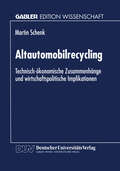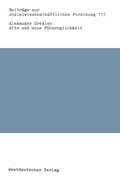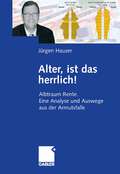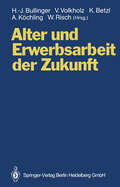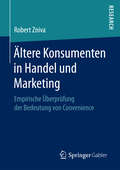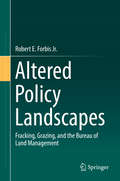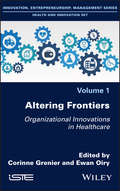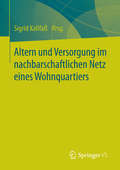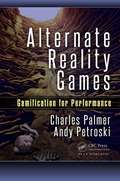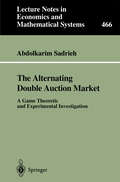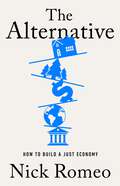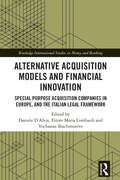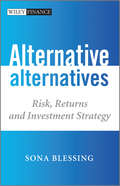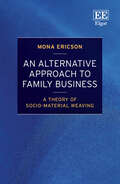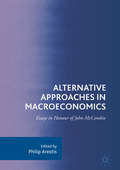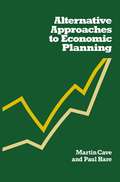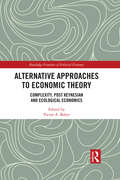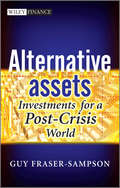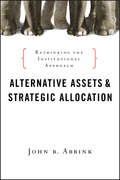- Table View
- List View
Altautomobilrecycling: Technisch-ökonomische Zusammenhänge und wirtschaftspolitische Implikationen
by Martin SchenkMartin Schenk untersucht, welchen Beitrag die Wirtschaftspolitik leisten kann und sollte, um auch zukünftig das Ziel eines umweltverträglichen Altautomobilrecycling zu erreichen.
Alte und neue Fürsorglichkeit: Gewerbeförderung von 1800 bis heute (Beiträge zur sozialwissenschaftlichen Forschung)
by Alexander DrexlerAlter, ist das herrlich!: Albtraum Rente. Eine Analyse und Auswege aus der Armutsfalle
by Klaus MagersuppeEinleitung Soziale Eislandschaft Wir schreiben das Jahr 2030. Aufgrund der verfehlten Rentenpolitik der letzten Jahrzehnte leben Millionen deutscher Rentner in Ghettos, in - nen sie vor sich hinvegetieren. Die Alten leiden unter Hunger, Durst und katastrophalen hygienischen Zuständen. Nach geltender Gesetzeslage ist es Ärzten in Krankenhäusern erlaubt, kranke Alte mit deren Einverstä- nis mittels einer Giftspritze zu töten, um der Krankenkasse weitere - handlungskosten zu ersparen. Dafür erhalten die Ärzte Prämien von den Kassen. Im Fernsehen gibt Gesundheitsministerin Petra Kerzel bekannt: „Den Generationenvertrag gibt es nicht mehr, denn zu einem Vertrag gehören immer zwei. Wir können uns die bisherigen Rentenzahlungen nicht mehr leisten. Deshalb wird es ab dem nächsten Monatsersten eine Einheitsrente in Höhe von 560 Euro für jeden Rentner geben. Das reicht zum Leben. “ Dies führt zum Aufstand der Rentner, die keine weiteren Mittel als die 560 Euro Einheitsrente zur Verfügung haben. Sie gründen das Kommando „Zornige Alte“. Da die Eigenbeteiligung für Arzneimittel bei 50 Prozent liegt, brechen die Alten in Apotheken ein und stehlen die für sie nicht mehr bezahlbaren Arzneimittel. Rentner überfallen Banken und verteilen Millionen Euro in bar an Schwerstkranke, damit diese sich die für sie lebensnotwendige Medizin kaufen können. Die Firma ProLife kauft Rentnern ihren lebenslangen Rentenanspruch ab und sichert ihnen mittels Prospektmaterial zu, sie nach Nakena in West- rika zu bringen, wo sie als Gegenleistung in idyllischen Wohnanlagen ihr Leben verbringen können.
Alter und Erwerbsarbeit der Zukunft: Arbeit und Technik bei veränderten Alters- und Belegschaftsstrukturen
by C. HerrmannÄltere Konsumenten in Handel und Marketing: Empirische Überprüfung der Bedeutung von Convenience
by Robert ZnivaDas vorliegende Buch beschäftigt sich mit der Auswirkung des demografischen Wandels auf das Marketing. Robert Zniva geht der Frage nach, ob es für Händler sinnvoll ist, sich den Bedürfnissen älterer Konsumentinnen und Konsumenten anzupassen und mehr Convenience für diese Zielgruppe anzubieten. Altern wird hierbei nicht nur als Jahreszahl, sondern als multidimensionaler Prozess untersucht.
Altered Policy Landscapes: Fracking, Grazing, and the Bureau of Land Management
by Robert E. Forbis Jr.This book documents the United States Bureau of Land Management's (BLM) shift from a rancher-dominated agency to an energy-dominated agency. This shift is analyzed by identifying the conditions under which the expansion of hydraulic fracturing (fracking) in the Rocky Mountain West triggered a political conflict between ranching and energy stakeholder groups. Through scrutiny of federal actions and policies implemented by the Executive Branch between 2004 and 2010, the book sheds light on the emphasis of domestic energy production during this time period, and how the traditional ranching and energy alliance was split by shifting policy interests. The book is meant for policy makers, natural resource agencies, and students and researchers engaged in political science, public administration, and natural resource management. Chapter 1 introduces readers to the case study at hand, and reviews literature on public land agencies and policies. Chapter 2 summarizes the legal history of public land management by the federal government, and the conditions that caused the BLM to favor energy development over ranching in the mid-2000's. Chapter 3 details the role of the Executive Branch (Bush-Cheney administration) in affecting the BLM's domestic energy policies and resource allocation, and chapter 4 analyzes the role of subgovernments in affecting the BLM's motivations too. Chapters 5, 6 and 7 contain first-hand accounts from government officials, state petroleum associations, and ranching supported interest groups to explore the concept of subgovernment stakeholder domination in policymaking, and analyze the similarities and differences between different policy-making elites. Chapter 8 concludes the text by summarizing subgovernment theory, mapping the behaviors of subgovernment actors, and discussing the implications for future political appointees in the direction of land-management agencies like the BLM.
Altering Frontiers: Organizational Innovations in Healthcare
by Corinne Grenier Ewan OiryHow can healthcare systems be transformed by reimagining their multiple silos to favor processes and practices that are more responsive to local, horizontal initiatives? Altering Frontiers analyzes numerous experiences, using a multidisciplinary approach, paying attention to certain actors, collectives and organizational arrangements.Through this work, levers are identified that promote lasting transformation: recognizing the legitimacy of the practices of many who are often "invisible"; trusting those who know their intervention territory; investing in methodological support; taking advantage of tools and procedures such as instruments for strategic and managerial discussion; and developing the capacity to absorb innovative ideas and experiences that circulate within the environment.
Altering Frontiers: Organizational Innovations in Healthcare
by Corinne Grenier Ewan OiryHow can healthcare systems be transformed by reimagining their multiple silos to favor processes and practices that are more responsive to local, horizontal initiatives? Altering Frontiers analyzes numerous experiences, using a multidisciplinary approach, paying attention to certain actors, collectives and organizational arrangements.Through this work, levers are identified that promote lasting transformation: recognizing the legitimacy of the practices of many who are often "invisible"; trusting those who know their intervention territory; investing in methodological support; taking advantage of tools and procedures such as instruments for strategic and managerial discussion; and developing the capacity to absorb innovative ideas and experiences that circulate within the environment.
Altern und Versorgung im nachbarschaftlichen Netz eines Wohnquartiers: Zur Kooperation eines Altenhilfeträgers und einer Wohnbaugenossenschaft bei der quartiersbezogenen Gemeinwesenarbeit
by Sigrid KallfaßDiese Publikation beinhaltet die Ergebnisse des vom Bundesministeriums für Bildung und Forschung geförderten Projekts „Altern und Versorgung im nachbarschaftlichen Netz einer Wohnbaugenossenschaft“. Die umfassende Studie liefert wichtige Aspekte zur Förderung einer Generationenbeziehung im nachbarschaftlichen Kontext.
Alternate Reality Games: Gamification for Performance
by Charles Palmer Andy PetroskiWhile formal training and communication are a foundational approach to developing employees in the workplace, alternate reality games (ARGs) provide a framework for increased and sustained engagement within business organizations. ARGs are transmedia experiences designed to generate engagement and immersive learning beyond what is achieved in forma
The Alternating Double Auction Market: A Game Theoretic and Experimental Investigation (Lecture Notes in Economics and Mathematical Systems #466)
by Abdolkarim SadriehThe alternating double auction market institution is presented as a discrete time version of the open outcry market. The game in extensive form is analyzed in an almost perfect information setting, using the concept of subgame perfectness. By applying two new equilibrium selection criteria, a general existence result is obtained for "impatience equilibria" of the game. All such equilibria are shown to have unique properties concerning the traded quantities and prices. The most important results are that the equilibrium prices are independent of the number of traders and are always very close to - if not inside - the range of competitive prices. The latter can be evaluated as game theoretic support for the convergence of prices to the competitive price. The process of price formation is traced by applying the learning direction theory and introducing the "anchor price hypothesis".
The Alternative: How to Build a Just Economy
by Nick RomeoA provocative debunking of accepted economic wisdom which offers a new pathway to a sustainable, survivable economy.Confronted by the devastating trends of the early twenty-first century - widening inequality, environmental destruction, and millions of workers stuck in precarious, soul destroying work - many economists, politicians and business leaders argue that there is no alternative. They cling to the dogmas that got us in this mess in the first place: private markets are more efficient than public ones; investment capital always flows where it is needed; inequality is an inevitable side effect of economic growth; people only behave well with the right incentives. But a growing number of academic economists, business owners, policy entrepreneurs, and ordinary people are rejecting these myths and reshaping economies to reflect their ethical and social values. Journalist Nick Romeo, who covers the world's most innovative economic and policy ideas for the New Yorker, takes us on an extraordinary journey through the unforgettable stories and successes of people working to build economies that are more equal, just, and liveable. Combining original, in-depth reporting with expert analysis, Romeo explores everything from fair pricing in the Netherlands to large scale cooperatives in Spain to public sector marketplaces offering decent work and real protection to gig workers in California and demonstrates there is an alternative.
Alternative Acquisition Models and Financial Innovation: Special Purpose Acquisition Companies in Europe, and the Italian Legal Framework (Routledge International Studies in Money and Banking)
by Daniele D’Alvia Ettore Maria Lombardi Yochanan ShachmuroveThis is the first book written in English on special purpose acquisition companies (SPACs) in the context of European and Italian financial law, introducing the topic with a general overview on the European stage. It is also the first book on European financial regulations of SPACs. As such, it is a groundbreaking reference text for SPAC studies at the international level. Alternative Acquisition Models and Financial Innovation: Special Purpose Acquisition Companies in Europe, and the Italian Legal Framework offers the most comprehensive overview of the current international financial regulations of SPACs in the EU and UK compared to the main legal system where SPACs originated—the US. This edited book is focused on finding a European legal framework for SPACs by discovering whether the Alternative Investment Fund Managers Directive (AIFMD) or the Undertakings for the Collective Investment in Transferable Securities Directive (UCITS) are applicable to them and why, as well as identifying the objectives of financial regulation of SPACs in the EU, US and UK. Essentially, the edited collection explores soft law and self-regulation instances against the state-based Westphalian approaches centred on hard law instances; describes practical examples of SPACs in Italy and Europe; and analyses the limits and perspectives of such investment vehicles on the Italian capital market as well as their possible uses as forms of shadow banking and venture companies at international levels.
Alternative Acquisition Models and Financial Innovation: Special Purpose Acquisition Companies in Europe, and the Italian Legal Framework (Routledge International Studies in Money and Banking)
by Daniele D'Alvia Ettore Maria Lombardi Yochanan ShachmuroveThis is the first book written in English on special purpose acquisition companies (SPACs) in the context of European and Italian financial law, introducing the topic with a general overview on the European stage. It is also the first book on European financial regulations of SPACs. As such, it is a groundbreaking reference text for SPAC studies at the international level. Alternative Acquisition Models and Financial Innovation: Special Purpose Acquisition Companies in Europe, and the Italian Legal Framework offers the most comprehensive overview of the current international financial regulations of SPACs in the EU and UK compared to the main legal system where SPACs originated—the US. This edited book is focused on finding a European legal framework for SPACs by discovering whether the Alternative Investment Fund Managers Directive (AIFMD) or the Undertakings for the Collective Investment in Transferable Securities Directive (UCITS) are applicable to them and why, as well as identifying the objectives of financial regulation of SPACs in the EU, US and UK. Essentially, the edited collection explores soft law and self-regulation instances against the state-based Westphalian approaches centred on hard law instances; describes practical examples of SPACs in Italy and Europe; and analyses the limits and perspectives of such investment vehicles on the Italian capital market as well as their possible uses as forms of shadow banking and venture companies at international levels.
Alternative Alternatives: Risk, Returns and Investment Strategy (The Wiley Finance Series #622)
by Sona BlessingIn the aftermath of the financial crisis, investors are searching for new opportunities and products to safeguard their investments for the future. Riding high on the wave of new financial opportunities are Alternative Alternatives (AA). However, there is a dearth of information on what Alternative Alternatives are, how they work, and how they can be profited from. The book defines what Alternative Alternatives are, based on research and the following hypothesis: If the source (origin) of the risk lies outside of the financial markets, then it should be insulated from the vagaries of those markets. The book identifies and examines such and other unique, idiosyncratic, and difficult to replicate sources of risk - assets and strategies. The recent credit and sovereign debt crisis have served to defend the hypothesis and have upheld the conclusion that alternative alternative assets and strategies offer a risk-return profile that is distinct to those offered by traditional and main stream hedge fund strategies. These strategies include timberland investing, insurance risk transfer, asset/loan based lending (aviation, shipping, trade, entertainment, litigation financing etc), collectables and extraction strategies such as volatility and behaviour finance. This book will be a one stop resource to the new investment class known globally as Alternative Alternatives (AA) and will provide a comprehensive but accessible introduction to these assets. It provides an in-depth analysis of the assets and strategies which will leave investors with everything they need to identify and allocate to the best AA for them. It reviews the asset on a standalone basis, providing an explanation of the product, its characteristics, a SWOT analysis, and details its risk/reward drivers. The book also looks at how to integrate the asset within a portfolio - its peculiarities, the challenges and the constraints of each. Next, the book shows how Alternative Alternatives are used in the real world, how they are implemented, and the results that they have achieved. Finally, the book looks at the scope, scalability and prospects for each asset in the future.
Alternative Alternatives: Risk, Returns and Investment Strategy (The Wiley Finance Series #591)
by Sona BlessingIn the aftermath of the financial crisis, investors are searching for new opportunities and products to safeguard their investments for the future. Riding high on the wave of new financial opportunities are Alternative Alternatives (AA). However, there is a dearth of information on what Alternative Alternatives are, how they work, and how they can be profited from. The book defines what Alternative Alternatives are, based on research and the following hypothesis: If the source (origin) of the risk lies outside of the financial markets, then it should be insulated from the vagaries of those markets. The book identifies and examines such and other unique, idiosyncratic, and difficult to replicate sources of risk - assets and strategies. The recent credit and sovereign debt crisis have served to defend the hypothesis and have upheld the conclusion that alternative alternative assets and strategies offer a risk-return profile that is distinct to those offered by traditional and main stream hedge fund strategies. These strategies include timberland investing, insurance risk transfer, asset/loan based lending (aviation, shipping, trade, entertainment, litigation financing etc), collectables and extraction strategies such as volatility and behaviour finance. This book will be a one stop resource to the new investment class known globally as Alternative Alternatives (AA) and will provide a comprehensive but accessible introduction to these assets. It provides an in-depth analysis of the assets and strategies which will leave investors with everything they need to identify and allocate to the best AA for them. It reviews the asset on a standalone basis, providing an explanation of the product, its characteristics, a SWOT analysis, and details its risk/reward drivers. The book also looks at how to integrate the asset within a portfolio - its peculiarities, the challenges and the constraints of each. Next, the book shows how Alternative Alternatives are used in the real world, how they are implemented, and the results that they have achieved. Finally, the book looks at the scope, scalability and prospects for each asset in the future.
An Alternative Approach to Family Business: A Theory of Socio-Material Weaving
by Mona EricsonThis insightful and innovative book proposes a new theory of socio-material weaving for studying and understanding family business. It dissolves the family business into activities, constituted of the sociality of human interactions and relations and interwoven with materials that extend in both a bodily-lived and spatial existential sense.Building on hermeneutic phenomenology, Mona Ericson explores a new approach to the field, which shifts focus away from entitized conceptions of family business contexts. Building on a ‘being-in-the-world’ understanding, the book emphasizes human entwinement with activities in amongst materials. Chapters draw insights from research on the social and the material, exploring the field through five unique stories that illustrate the intertwinement of family business activities and materials associated with buildings and land. Taking a critical stance towards systems-oriented family business research, Ericson weaves together the social and the material in association with narrative truth.An innovative and imaginative exploration of an established field of study, this book is crucial reading for scholars, researchers and graduate students of family business, opening up new ways of approaching the field in scholarly work. It will also benefit practitioners through practical insights into the challenges family business owners face when establishing and managing business activities.
Alternative Approaches in Macroeconomics: Essays In Honour Of John Mccombie
by Philip ArestisThis book honours Professor John McCombie’s retirement by exploring a variety of themes, theories and debates in non-orthodox macroeconomics. With contributions from leading scholars, the book covers diverse ground in economic thought, policy, empirical work and modelling. It demonstrates ongoing presumptions and asks probing questions of topical questions from the increase of income equality to the international variation of productivity investment. This collection will appeal to academics and students with an interest in the history of macroeconomic thinking.
Alternative Approaches in Macroeconomics: Essays in Honour of John McCombie
by Philip ArestisThis book honours Professor John McCombie’s retirement by exploring a variety of themes, theories and debates in non-orthodox macroeconomics. With contributions from leading scholars, the book covers diverse ground in economic thought, policy, empirical work and modelling. It demonstrates ongoing presumptions and asks probing questions of topical questions from the increase of income equality to the international variation of productivity investment. This collection will appeal to academics and students with an interest in the history of macroeconomic thinking.
Alternative Approaches to Economic Theory: Complexity, Post Keynesian and Ecological Economics (Routledge Frontiers of Political Economy)
by Víctor A. BekerThe 2007–2008 financial crisis exposed the shortcomings of mainstream economic theory with economists unprepared to deal with it. In the face of this, a major rethinking of economics seems necessary and in presenting alternative approaches to economic theory, this book contributes to the rebuilding of the discipline. This volume brings together contributions from different perspectives and theoretical approaches that address the challenge of updating the economic theory corpus and seek to recover prestige for this discipline after the failure of neoclassical economics. It addresses a range of topics, including the complexity approach to economics, category theory, the Post-Keynesian approach to micro and macroeconomics, financialisation, multidimensional analysis and ecological economics. The book is aimed at economics scholars, researchers, academics and practitioners, as well as upper undergraduates and graduates in this area of knowledge. It may also be of interest for people interested in methodological issues in economics and the relationship between economic theory and the real world.
Alternative Approaches to Economic Theory: Complexity, Post Keynesian and Ecological Economics (Routledge Frontiers of Political Economy)
by Victor A. BekerThe 2007–2008 financial crisis exposed the shortcomings of mainstream economic theory with economists unprepared to deal with it. In the face of this, a major rethinking of economics seems necessary and in presenting alternative approaches to economic theory, this book contributes to the rebuilding of the discipline. This volume brings together contributions from different perspectives and theoretical approaches that address the challenge of updating the economic theory corpus and seek to recover prestige for this discipline after the failure of neoclassical economics. It addresses a range of topics, including the complexity approach to economics, category theory, the Post-Keynesian approach to micro and macroeconomics, financialisation, multidimensional analysis and ecological economics. The book is aimed at economics scholars, researchers, academics and practitioners, as well as upper undergraduates and graduates in this area of knowledge. It may also be of interest for people interested in methodological issues in economics and the relationship between economic theory and the real world.
Alternative Assets: Investments for a Post-Crisis World (The Wiley Finance Series)
by Guy Fraser-SampsonThe investment landscape has changed dramatically over the last few years, destroying many of the old certainties by which investors lived their lives. In particular, it has shaken belief in the ability of traditional asset types such as bonds and equities to protect them from abnormal market conditions, and it has brought home how closely correlation between different markets can be squeezed together by extreme pressure. Future investors will have to regard so-called "alternative" assets as essential elements within their portfolios, and be prepared to deal with the complexities that this will entail. This will in turn force a re-appraisal of core concepts such as "risk" and "return", not least because some alternative asset classes do not lend themselves well to traditional return measures. Exciting times lie ahead, but a thorough working knowledge of the various alternative asset classes will be an essential pre-requisite to success, and perhaps even to survival. Alternative Assets meets investor's need for a guide on where to allocate in this new climate. It provides investors with a primer on each alternative asset class, as well as practical tips on the pros and cons, implementation, returns analysis, fees and costs. It also offers introductory guidance on how to set investment targets, and how alternative assets can be accommodated within the allocation process. Each chapter gives useful background knowledge on a particular asset type, including a discussion of whether a satisfactory beta return level exists and, if so, the different ways in which it might be accessed. Written by best-selling author Guy Fraser-Sampson, this book guides investors through the new look alternative investment arena, providing post-financial crisis perspective and investment advice on the alternatives landscape.
Alternative Assets: Investments for a Post-Crisis World
by Guy Fraser-SampsonThe investment landscape has changed dramatically over the last few years, destroying many of the old certainties by which investors lived their lives. In particular, it has shaken belief in the ability of traditional asset types such as bonds and equities to protect them from abnormal market conditions, and it has brought home how closely correlation between different markets can be squeezed together by extreme pressure. Future investors will have to regard so-called "alternative" assets as essential elements within their portfolios, and be prepared to deal with the complexities that this will entail. This will in turn force a re-appraisal of core concepts such as "risk" and "return", not least because some alternative asset classes do not lend themselves well to traditional return measures. Exciting times lie ahead, but a thorough working knowledge of the various alternative asset classes will be an essential pre-requisite to success, and perhaps even to survival. Alternative Assets meets investor's need for a guide on where to allocate in this new climate. It provides investors with a primer on each alternative asset class, as well as practical tips on the pros and cons, implementation, returns analysis, fees and costs. It also offers introductory guidance on how to set investment targets, and how alternative assets can be accommodated within the allocation process. Each chapter gives useful background knowledge on a particular asset type, including a discussion of whether a satisfactory beta return level exists and, if so, the different ways in which it might be accessed. Written by best-selling author Guy Fraser-Sampson, this book guides investors through the new look alternative investment arena, providing post-financial crisis perspective and investment advice on the alternatives landscape.
Alternative Assets and Strategic Allocation: Rethinking the Institutional Approach (Bloomberg #94)
by John B. AbbinkAn insightful guide to making strategic investment allocation decisions that embraces both alternative and conventional assets In this much-needed resource, alternative and portfolio management expert John Abbink demonstrates new ways of analyzing and deploying alternative assets and explains the practical application of these techniques. Alternative Assets and Strategic Allocation clearly shows how alternative investments fit into portfolios and the role they play in an investment allocation that includes traditional investments as well. This book also describes innovative methods for valuation as applied to alternatives that previously have been difficult to analyze. Offers institutional investors, analysts, researchers, portfolio managers, and financial academics a down-to-earth method for measuring and analyzing alternative assets Reviews some of the latest alternatives that are increasing in popularity, such as high-frequency trading, direct lending, and long-term investment in real assets Outlines a strategic approach for including alternative investments into portfolios and shows the pivotal role they play in an investment allocation Using the information found in this book, you'll have a clearer sense of how to approach investment issues related to alternative assets and discover what it takes to make these products work for you.
